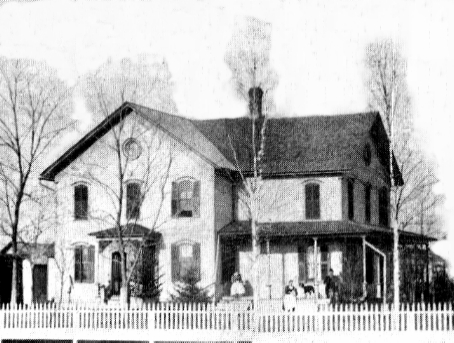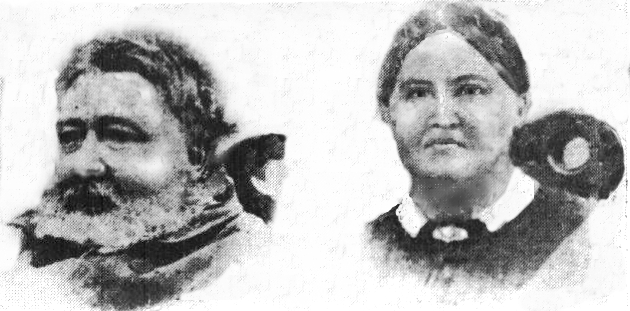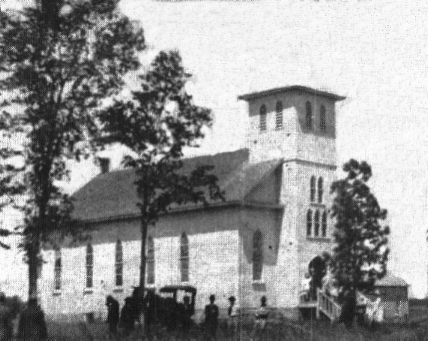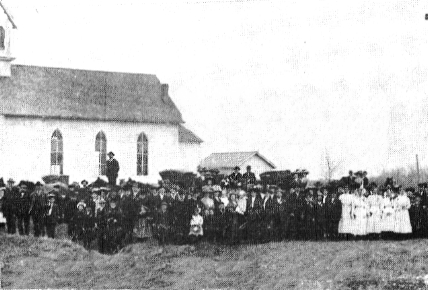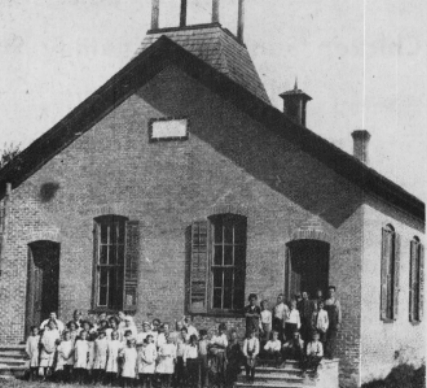| Oconto County Reporter
November 11, 1971 Contributed by Dave Cisler from the scrapbook of Miriam C. Barribeau CISLER Transcribed by Diane Horn Little Suamico “Hummed” in the Good Old Days By Alice Lorang Koehne
Suamico is an Indian name meaning yellow sand or sand hills, so named by the Menominees and Potowatomis who first inhabited the area. These Indians were for the most part friendly and peace-loving and the early settlers of the region learned much from them. The mother of Chief Oshkosh was born in Little Suamico and the colorful chief himself, for whom the city of Oshkosh is named, is believed to have been born somewhere between Little Suamico and Pensaukee. The Little Suamico of today is a small village located about half way between Oconto and Green Bay. It boasts two churches, two stores, two taverns, three cemeteries and a scattering of homes. One finds it difficult to believe that in the early 1870’s, the village was well on its way to becoming a town of note. Strategically located in stands of the world’s finest white pine, the Little Suamico river furnished easy access to Green Bay, thus insuring transportation for the products of the five mills which lined its banks. The bay itself was teeming with fish, and small farms were cleared so that food was no problem once the population began to grow. When the railroad was laid through the village in 1871, the future of Little Suamico seemed bright indeed. However, two natural disasters soon ended any hope of the small community becoming a major city. In October 1871, the fire which completely destroyed the village of Peshtigo to the north, also took its toll of the vast timber stands in this area. Six years later the tornado that wiped out the neighboring village of Pensaukee, destroyed many of the remaining timber stands that would have kept the Little Suamico mills supplied for years to come. Gradually the mills moved to other areas and farming and fishing became the two major means of livelihood in the small village. The first white man known to have lived in Little Suamico
was Phillip Frank. He was operating a small water mill on the Little
Suamico river when the first permanent white settlers arrived. When
he came or when he left is not known.
The first settlers were Gustavus and Caroline Grosse and their four young sons, John, William, Charles and Gustavus, Jr. Gustavus Grosse, Sr., a farmer and merchant, immigrated from Potsdam, Germany, in 1849, but it wasn’t until March of 1852 that he and his family settled in what was to become Little Suamico. Their first home was on Tippits Creek (named for an Indian squaw) near where county trunks S and J now converge. Gustavus and his son, John, (then a boy of 14) had made a trip up the Little Suamico river in September 1851, but they had to wait until the following spring to return because the family would have to camp out before a shelter could be built. However, since there was no road from Green Bay except the winding Indian trail, they had to time their trip to the new land while there was still ice on the bay. Those first weeks in the wilderness must have been extremely trying, for the family suffered much from the cold. For three years the Grosses had no neighbors but the Indians. The nearest settlements were at Pensaukee to the north and Green Bay to the south, accessible only by traveling the Indian trails through the woods, or by boat along the bay shore. Gustavus took up land from the government along the river and established a farm. In Germany, he had been employed as “keeper of the king’s forest” and it was the sight of the “prairies” at Little Suamico that probably influenced his settling there. Before long he had a trading post on the south side of the river and was also engaged in fishing. Eventually other pioneers began to push north into the wilderness. Fred and Moritz Post, natives of Frankfort, Germany, arrived in 1855 and settled on land at the mouth of Tippits creek. The following year Ernest Kuntze, a tanner from Germany, arrived from Milwaukee and also settled along the creek. Later he built a tannery in Little Suamico. When the church was established, at 90 years is the oldest living member of the congregation. Today St. John’s Lutheran church is affiliated with Trinity Lutheran church in Oconto, American Synod, with Rev. John Kilde serving both parishes as pastor. Catholics began arriving as early as 1853 and were served, whenever possible, by the church in Duck Creek, 16 miles to the south. Members traveled either by board or on foot along the Indian trials through the woods. By the time of the Civil War, there were about a dozen
Catholic families in the area, among them were Nelson Piouff, Lauer, Charles
Detiege, Julian De Maiffe, Alois B. Zoeller, Leon, John Bergman, Moritz
Rost, William Blazer and Felix Richard. As the number of families
grew, they began to talk about building a church. In 1885 a petition
was sent to the Bishop of Green Bay (many of the signers were non-Catholics),
and a building fund of $1,000 was raised, but the program failed to go
through.
In 1888 plans to establish a Catholic church in Little Suamico were begun again. A great picnic was held with the Grosse band providing the music and people gathered from miles around to help their Catholic friends in their endeavor. In the winter of 1888 or at least by the following spring, the first Catholic church in the village was completed and named St. Leo’s. In 1895 the name was changed to St. Pius’s. This building served as a place of worship for 15 years. On August 10, 1903 a larger church was built in a more central location and remains as a place of worship today. Actually, it should be noted that the observations of the Catholic faith in this area goes back to 1669 with Indians living here were converted by the Jesuit missionaries arriving from Canada. Catholicism has been practiced on the shores of the Little Suamico river for over 300 years. The first school in Little Suamico was built in 1864 west of the present railroad tracks, a simple wooden structure measuring 16x25 feet. Later, in 1903, the school was moved to the present – and third – Little Suamico school. The beginnings of school district No. 4 go back to 1892 when the settlers north of the village organized a school. Since there was no building for classes, he first teaching was done in the home of Obadiah Perdon. In 1895 a building was erected by Gust Papenfus where county trunk J and the Lade Beach road now meet. During the 66 years of its existence, the Cottonwood Grove school was served by 34 teachers. Early in 1960 the little one-room schoolhouse was closed and district No. 4 became part of the Oconto Falls school district. The building was sold to the congregation of St.John’s church and now serves as their parish hall. As the town grew, the need for a public cemetery became evident. During the early years, burials were made right on the home property of the deceased. The Grosse family’s cemetery was established on the bank of the Little Suamico river where, it is believed, in 1851 Gustavus, Sr. and John first set foot on the land that was to become their home. All of the Grosse descendants and their spouses are buried here. No one knows when St. John’s church cemetery was begun,
but burials were made here as late as 1925 even though a public cemetery
had been established almost 50 years before. This church cemetery
is still cared for by the men of the parish.
A town cemetery was established in 1873 when five acres of land were purchased, but it wasn’t until 14 years later that burials were made. The land had to be cleared, fenced, platted and a road had to be built before it could be used. This must have been a tremendous job since practically all of the work was done by hand. In 1944 two additional acres of land were purchased and this section was surveyed and platted in 1954. Eight acres purchased in 1965 remain to be developed at a future date. IN 1967 the Riverside Cemetery Association was formed and there is now perpetual care for all the lots. The pioneer spirit which was the foundation of the village of Little Suamico is not dead. Although there is no longer any need for neighbors to gather for the old husking bees, barn raisings and other activities in the interest of the public, good people join hands to work together when the need is felt. This was evidenced by the foundation of the Little Suamico Recreation Association which was incorporated on March 29 of this year. The village needed a community center, so land was purchased on the river bank to provide a park for year-round use. A 20x80-foot building was erected by the men of the village and a group of women applied stain to the exterior. On September 5, the annual Little Suamico Day was held on the new grounds with the entire community contributing time and donations to make it the best-ever thus far. Long range plans are being made for baseball diamonds and a skating rink. The recreation area, built by the citizens themselves, will be a community center of which the entire population of the village and surrounding areas can be proud. The village that had its beginnings on the banks of the Little Suamico river over a century ago, became a melting pot of many nationalities and incorporated the best of many cultures into its foundation. Today the spirit of “doing together for the common good” still lives on. Little Suamico Notes
The A.C. Conn mill is still going. Josel Lucia and William Taylor are operating a shingle mill. Anson Eldred & Son Company is gradually being moved to Fort Howard. The C. Grosse and G. A. Grosse mills are still operating. Sobieski started by Norwegian land salesman By Rita Allen Hofa Park was named to honor the “founder” of the dominantly Polish Catholic community called Sobieski. But the man so singularly recognized was neither Polish, nor Catholic. He wasn’t, in fact, even named Hofa. He was one J. J. Hoff (variously spelled Hof, Huff, Hoff), who came to this country from Norway as a youth, and eventually went to work as a land salesman for the John Mariner Real Estate Company in Milwaukee. Among the company’s holdings was an option on a vast area of cutover timber grounds and Hoff was sent out to sell parcels of it. The area, when he arrived about 1895, was still largely wilderness, traversed only by a narrow bumpy trail, with wolves howling in the woods that pressed onto the trail from both sides. Nevertheless, having once arrived, Hoff was so impressed with the country that he decided to go into business for himself and built an office with a large sign over the door reading – “J.J. Hoff Land Co.” Employing three salesman named Liberski, Koldrowicz and Zielinshi, he sent them out to Midwest states to seek out immigrant countrymen and convince them of the advantages settling in Wisconsin. Their efforts, plus circulars mailed by Hoff to all the states, were highly successful, and before long a Polish community began building up around the land office. Land, that now sells for $100 or more an acre, would then be bought for $15. The people named their community "Sobieski" after King John Sobieski of Poland. Meanwhile, Hoff was busy in a private development. He had a well dug, 850 feet deep, along with an excavation for a small lake, with the well water flowing into the lake continuously. He then stocked it with game fish. His next project was to arrange to have the railroad depot – then stationed a few miles south – moved to this village, and the name “Sobieski” placed on it. The community continued to grow as the hard working “poles” cleared the land for farming, using horses and a stump puller, and built their unpretentious log houses and barns. One of the first businessmen was Frank Peplinski, who operated a general store, hotel and tavern. Then came Walter Broniszewski, who also had a tavern, bough from a Mr. Dudy. Broniszewski later built a general store to replace an older structure that had served as a meat market. The property is presently the residence and tavern of Clayton VanLanen. The town also had a five and dime store for a time, but the business failed and was taken over by Thomas Jachiniak, who turned it into a cheese factory. Cheese is still turned out there today by I. J. Galikowski. There was another cheese factory also, a building which changed hands many times, and is now a tavern operated by Tony Kroll. In the early years John Hernet had a blacksmith shop on a site where the Frank Pomprowitz, Sr. family lives. Another pioneer resident, John Kucik, sold his grocery store to Casimer Pomprowitz, and upon the latter’s death in the late 1950’s, it passed to his sister, Mary. Mary and her husband, Carl Nelson, recently remodeled the store and tavern. Next to the Nelson’s was a grocery owned by the Sot family, but the store burned early in the 1930’s. As you enter Sobieski, traveling east on county trunk S, the first business establishment seen is Golonka’s tavern, owned by Florence Golonka, and previously the property of Vincent Scezpanksi. Sobieski’s post office and Truskowski’s grocery store are housed today in the town’s first general store. For the first few years there was no church in Sobieski
and the people attended mass in surrounding parishes, or in the homes of
Sylvester Rorzych, a Mrs. Jankie and Mrs. Charles Deteige. Then the
town’s godfather, John Hoff, donated land for a church and cemetery and
in 1897 a house of worship was built. As more settlers arrived, the
church became too small, and the priest, Father Polaczk, encouraged the
parish to build a new St. John Cantius church. Ground for the new
sanctuary was broken in 1902. The congregation was preparing to celebrate
its golden jubilee, falling on October 20, 1952, when two months earlier
a bolt of lightning struck the frame building and demolished it.
In 1928 a two-room school was constructed and dedicated by the Most Rev. Bishop Paul Rhode and opened in September of that year with 80 pupils. The old church was converted into a home for the nuns. Although Mr. Hoff was not a Catholic, he occasionally attended services at St. John’s. During his last illness, and while he was a patient at St. Vincent’s hospital in Green Bay, he received instructions and was baptized a Roman Catholic. That was on September 18, 1910. The following October 9 he died and was buried in the church cemetery at Sobieski. Hofa Park, and an imposing tombstone, still stand as
a memorial to the Norwegian to whom Sobieski owes so much. But the
lake is gone. It was filled in by Ronald Truskowski when he acquired
the lot, and the residence of the Klimaszewski family now stands on the
site.
|
